Barcelona, it turns out, isn’t just about Gaudi anymore. A recent Nomad eSIM study suggests it’s now the world’s most packed tourist spot, surpassing even the Colosseum and Great Wall. While its 20.37 million annual visitors and a density of 201,722 per square kilometer blow away places like Cancun (147,887), Porto (143,902), and even New York (137,712), the Sagrada Familia’s magnetic pull has, perhaps unsurprisingly, stirred “tourismphobia”—a local pushback against mass tourism’s effects.
The Rise of Tourismphobia
This “tourismphobia,” or a dislike of overtourism, is on the rise in Barcelona. Locals report feeling, well, uncomfortable in their own city, often avoiding the Barri Gòtic, the beach, Plaça Catalunya, the Sagrada Familia itself, and Passeig de Gràcia. Some even take the long way around to dodge these zones, pushing for policy changes to curb the crowds and support local shops getting squeezed out.
Experts are saying that Spain might not be in a full crisis yet, but the sheer concentration of tourists in Barcelona’s old center—complicated by those somewhat unregulated tourist rentals—is definitely a point of friction. Protests popped up, particularly in 2025, showing resident’s worries about strained resources and the dilution of their cultural character.
The Consequences of Overtourism
The consequences of overtourism in Barcelona? Both seen and unseen. We’re talking overloaded infrastructure – long lines, slow traffic, and restricted access. Plus, prices get jacked up by the high demand, noise goes up, and so does the waste. An Evaneos survey showed that 4 in 10 holiday town residents think tourist apartments are pushing out locals, and everyone pretty much agrees that tourist hotspots are way too crowded.
The less obvious impacts are worrisome, too. The eroding cultural identity and the growing tension between locals and tourists threaten Barcelona’s appeal and its long-term economic health. Experts suggest that this decline could, in the long run, reduce the city’s allure.
The Positive Side of Tourism
Okay, despite the problems, tourism does bring benefits. Turespaña reported that tourism employment in Spain was up to over 2.9 million in April 2025, with nearly 100,000 new jobs. A key UN Tourism director points out the wealth creation, cultural exchange, and job growth, according to UN Tourism and IPSOS studies.
Shifting Travel Trends
Travel’s evolving, too. Simon-Kucher’s Travel Trends 2025 study says that post-pandemic travelers are increasingly after less crowded tourist spots. About 29% of travelers in Spain have already changed or ditched plans because of overtourism, and a good 63% say they’ll steer clear of packed places in the future. France is showing similar trends, with roughly 69% of French travelers avoiding overtouristed spots.
Causes of Overtourism
The European Commission’s report, Unbalanced Tourism Growth at the Destination Level, lists a few drivers of this overtourism. Things like the travel-loving Millennial generation and longer lifespans, coinciding with economic growth and higher living standards. More paid time off, technological improvements, and greater media access have all helped. And the rise of budget airlines and transport networks have boosted weekend getaways and city trips, fueling a kind of growth-at-all-costs approach to global tourism.

